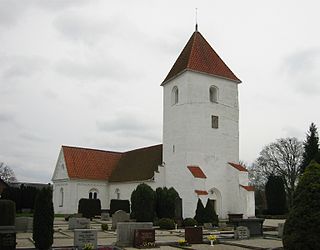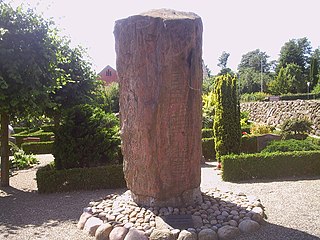
The Gunderup Runestone, or DR 143, is located in Gunderup, North Jutland County, Jutland, Denmark. It is notable because it is one of few runestones raised in commemoration of a woman.

The Hällestad Runestones are three runestones located in the walls of Hällestad Church in Torna-Hällestad, about 20 kilometers east of Lund in Skåne, southern Sweden. Their Rundata identifiers are DR 295, 296, and 297. DR 295 is notable because it is held to be raised in memory of a warrior who fell in the legendary Battle of the Fýrisvellir, near Uppsala, Sweden between the Jomsvikings led by Styrbjörn the Strong and Styrbjörn's uncle Eric the Victorious, the king of Sweden, c. 985. The other stones were raised by the same people, and they probably formed a monument together in memory of comrades lost in the battle. The Karlevi Runestone, the Egtved Runestone and the Sjörup Runestone may be connected to them.
The England runestones are a group of about 30 runestones in Scandinavia which refer to Viking Age voyages to England. They constitute one of the largest groups of runestones that mention voyages to other countries, and they are comparable in number only to the approximately 30 Greece Runestones and the 26 Ingvar Runestones, of which the latter refer to a Viking expedition to the Caspian Sea region. They were engraved in Old Norse with the Younger Futhark.
The Viking runestones are runestones that mention Scandinavians who participated in Viking expeditions. This article treats the runestone that refer to people who took part in voyages abroad, in western Europe, and stones that mention men who were Viking warriors and/or died while travelling in the West. However, it is likely that all of them do not mention men who took part in pillaging. The inscriptions were all engraved in Old Norse with the Younger Futhark. The runestones are unevenly distributed in Scandinavia: Denmark has 250 runestones, Norway has 50 while Iceland has none. Sweden has as many as between 1,700 and 2,500 depending on definition. The Swedish district of Uppland has the highest concentration with as many as 1,196 inscriptions in stone, whereas Södermanland is second with 391.
The Baltic area runestones are Viking runestones in memory of men who took part in peaceful or warlike expeditions across the Baltic Sea, where Finland and the Baltic states are presently located.

The Simris Runestones are two 11th-century runestones located at the vicarage of Simris, near Simrishamn, in southeasternmost Scania, Sweden. They were rediscovered in a church wall in 1716 during a restoration of the church. Although the territory was Danish at the time, they were made in the Swedish style of Uppland. One of the stones is notable in being one of the earliest native Scandinavian documents that mention Sweden.

The Bjäresjö Runestones are three Viking Age memorial runestones originally located adjacent to Bjäresjö Church in Bjäresjö, which is about 3 kilometers northwest of Ystad, Skåne County, Sweden. Two of the stones were discovered near the church, and two of the stones have been moved to other nearby locations. Although these three stones are located in Sweden, they have been given Danish designations because Scania was part of the historic Denmark.

Danish Runic Inscription 48 or DR 48 is the Rundata catalog number for a Viking Age memorial runestone from Hanning, which is about 8 km north of Skjern, Denmark. The runic inscription features a depiction of a hammer, which some have interpreted as a representation of the Norse pagan god Thor, although this interpretation is controversial.

The Sövestad Runestones consist of a Viking Age image stone and memorial runestone found near Krageholm Castle, which is about two kilometers west of Sövestad, Skåne County, Sweden.

The Västra Nöbbelöv Runestone, listed as DR 278 in the Rundata catalog, is a Viking Age memorial runestone located in Västra Nöbbelöv, which is about 3 kilometers east of Skivarp, Skåne County, Sweden, and was in the historic province of Scania.

The Læborg or Laeborg Runestone, listed as DR 26 in the Rundata catalog, is a Viking Age memorial runestone located outside of the village hall or Forsamlinghus in Læborg, which is about 3 kilometers north of Vejen, Denmark. The stone includes two depictions of the hammer of the Norse pagan god Thor.

The Ålum Runestones are four Viking Age memorial runestones which are located at the church in Ålum, which is 9 km west of Randers, Denmark. One of the stones refers to a man with the title drengr and two of the other stones were raised by the same family.

The Asferg Runestone, listed as DR 121 in the Rundata catalog, is a Viking Age memorial runestone found at Asferg, which is about 10 km northeast of Randers, Aarhus County, Region Midtjylland, Denmark.

The Aars stone or DR 131 is a late Viking Age runestone located on a mound in the churchyard at Aars in Himmerland, Denmark. Dated to the late 10th to early 11th century, it bears an inscription in the Younger Fuþark in memory of Toke Gormsson, known as Valtoke, who died at the Battle of Fýrisvellir.

The Sønder Vinge stone 2 or DR 83 is a Viking Age runestone engraved in Old Norse with the Younger Futhark runic alphabet. The stone is in granite and was discovered in 1866 as a corner stone of Sønder Vinge Church, positioned with the runic inscription outwards. It is presently located in the porch of the church. It is probably from the period 970-1020 due to runic and linguistic features. It is 180 cm tall, 132 cm wide and 35 cm thick. Parts of the runic inscription have eroded which makes some runes hard to read. The style of the runestone is the runestone style RAK.

The Glemminge stone or DR 338 is a Viking Age runestone engraved in Old Norse with the Younger Futhark runic alphabet. It is found in the wall of Glimminge church in Scania, in Ystad Municipality in Sweden. The style of the runestone is the runestone style RAK.

The Egtved Runestone or DR 37 is a Viking Age runestone engraved in Old Norse with the Younger Futhark runic alphabet. It was discovered in 1863, by a master mason named Anders Nielsen from Starup, in the southern part of the cemetery of Egtved church. It is dated to the period 900–1020. The stone is in granite and measures 80 cm in height, 55 cm in width and 43 cm in thickness. The style of the runestone is the runestone style RAK.
The Tvorup/Torup stone or DR 154 † was a Viking Age runestone engraved in Old Norse with the Younger Futhark runic alphabet, which has disappeared. According to Skonvig the stone would have been located just inside the door of church of Torup, having been moved there from a mound east of the church. The stone must have been lost while being transported to Copenhagen because nothing more is known about it. Skonvig reported that the stone was 2.5 Danish ells high and 1 ell wide. It was made by the same runemaster who made DR 155, and Lerche Nielsen (2010:244f) suggests that the two stones may actually be the same stone. The stone is dated to the period 970–1020, and the style of the runestone was the runestone style RAK.

The Fuglie stone 1 or DR 259 is a Viking Age runestone engraved in Old Norse with the Younger Futhark runic alphabet. It was first mentioned by Skonvig and it is still located in its original location on a Nordic Bronze Age mound next to the church of Fuglie, Skåne, Sweden. There are many local legends and traditions about the stone. The stone is 105 cm tall, 63 cm wide, and 33 cm thick. The stone is dated to the period 970–1020, and the style of the runestone was the runestone style RAK.

The Nylarsker stone 2, Ny Larsker stone I or DR 380 is a Viking Age runestone engraved in Old Norse with the Younger Futhark runic alphabet on Bornholm. The runestone was discovered in 1643 and first mentioned in Ole Worm's Monumenta Danica. It was to be found outside the entrance of Nylars Church until 1855. It is securely dated to the period 1075–1125, and belongs to a group of Bornholm runestones that were made during the transition from the Viking Age to the Nordic Middle Ages. It made in sandstone and it is 186 cm tall, 146,5 cm wide and 17 cm thick, and the style of the runestone is the runestone style RAK.




















